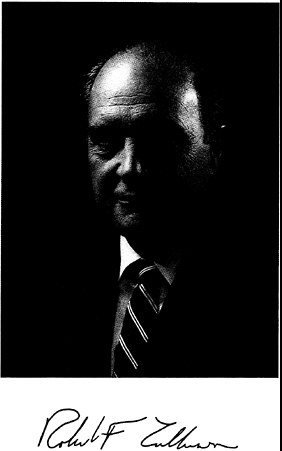ROBERT F. GILKESON
1917–1993
BY J. L. EVERETT
ROBERT F. GILKESON, engineering pioneer, leading utility executive, and civic leader, died on March 13, 1993, at the age of seventy-five.
Bob Gilkeson joined the Philadelphia Electric Company (PECO) as a cadet engineer after graduating in electrical engineering from Cornell University in 1939. Throughout World War II he served as an officer in the U.S. Army, and then he returned to Philadelphia Electric. In 1951 he was granted a leave of absence to join Westinghouse Electric Corporation, where he participated in the development, construction, and operation of the prototype nuclear propulsion system for the submarine Nautilus, the world's first nuclear naval vessel.
Upon returning to PECO in 1953, he was appointed assistant to the superintendent of generating stations, and in 1956 he became superintendent of Eddystone Generating Station, one of the nation's early supercritical steam electric generating stations. The Eddystone Station used steam conditions of 5,000 pounds per square inch and 1,200 degrees Fahrenheit, the highest ever employed commercially. During his years at Eddystone (1956–1960), Bob Gilkeson made significant contributions to the use of very high steam conditions in electric generation.
In 1961 he was elected vice-president of engineering and research at PECO, and in 1962 executive vice-president and a member of the company's board of directors. He was elected
president in 1965, president and chief executive officer (CEO) in 1970, and CEO and chairman of the board in 1971. He served as chairman until his retirement in 1982. Even then he continued to serve as chairman of the executive committee until 1988.
Bob Gilkeson guided his company into the use of nuclear energy to generate electricity during his tenure in office. First, PECO participated in the development, design, construction, and operation of Peach Bottom Atomic Power Station's Unit Number 1. This 40-megawatt prototype generating plant used a high-temperature, graphite-moderated, helium-cooled nuclear reactor as its heat source. In the 1960s he oversaw the design, construction, and operation of PECO's first large commercial nuclear generating plant, Peach Bottom Units Numbers 2 and 3. This subsequently led to the construction and operation of a similar large nuclear plant at Limerick, Pennsylvania.
His leadership in the nuclear power field led to his appointment by the governor of Pennsylvania, in 1966, to the state's Advisory Committee on Atomic Development and Radiation Control. In 1968 he founded Radiation Management Corporation (RMC), a medical service organization, which prepared and trained nuclear plant personnel and local hospitals to deal with injuries involving radiation. A quarter century later, RMC is serving utility companies throughout the United States.
Bob Gilkeson's leadership in the U.S. utility industry was recognized by his election as chairman of the Edison Electric Institute in 1977. He also served on the boards of the American Gas Association and the Electric Power Research Institute.
He was elected to the National Academy of Engineering in 1978, and in 1982 was nominated by President Reagan, and confirmed by the U.S. Senate, to the National Science Board, the policymaking body of the National Science Foundation. He was a member of the Institute of Electrical and Electronics Engineers, the National Society of Professional Engineers, the Society of American Military Engineers, and Eta Kappa Nu.
Bob Gilkeson was also dedicated to and active in his community. He served as a trustee of the Philadelphia Port Corporation, a director of the Greater Philadelphia Chamber of Commerce, and a director of the Old Philadelphia Develop
ment Corporation. He served as chairman of the Penjerdel Council, covering the regional economic interests of the Delaware Valley. In 1970 he served as general chairman of the United Fund Torch Drive for greater Philadelphia and later as a trustee of the United Way. He served as a trustee of the Penn Mutual Life Insurance Company and as a member of the board of managers of the Germantown Savings Bank. Bob was also active in the affairs of his alma mater, Cornell University, and served as a trustee of the Williamson Free School of Mechanical Trades and the Northern Home for Children.
The Poor Richard Club of Philadelphia presented its gold medal to Mr. Gilkeson in 1976, for his pioneering contributions to nuclear power and for his outstanding civic leadership.





